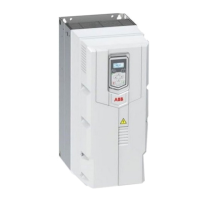Program features 39
Speed control mode
The motor follows a speed reference given to the drive. This mode can be used either
with estimated speed used as feedback.
Speed control mode is available in both local and external control. It is supported in
vector motor control only.
Speed control uses speed reference chain. You can select speed reference using
parameters in group 22 Speed reference selection on page 217.
Torque control mode
Motor torque follows a torque reference given to the drive. Torque control mode is
available in both local and external control. It is supported in vector motor control
only.
Torque control uses torque reference chain. Select torque reference with parameters
in group 26 Torque reference chain on page 235.
Frequency control mode
The motor follows a frequency reference given to the drive. Frequency control is
available in both local and external control. It is supported in scalar motor control only.
Frequency control uses frequency reference chain. You can select frequency
reference using parameters in group 28 Frequency reference chain on page 240.
Special control modes
In addition to the above-mentioned control modes, the following special control
modes are available:
• Process PID control. For more information, see section Process PID control (page
50).
• Emergency stop modes OFF1 and OFF3: Drive stops along the defined
deceleration ramp and drive modulation stops.
• Jogging mode: Drive starts and accelerates to the defined speed when the
jogging signal is activated. For more information, see section Jogging (page 73).
• Pre-magnetization: DC magnetization of the motor before start. For more
information, see section Pre-magnetization (page 70).
• DC hold: Locking the rotor at (near) zero speed in the middle of normal operation.
For more information, see section DC hold (page 70).
• Pre-heating (motor heating): Keeping the motor warm when the drive is stopped.
For more information, see section Pre-heating (Motor heating) (page 71).
Drive configuration and programming
The drive control program performs the main control functions, including speed,
torque and frequency control, drive logic (start/stop), I/O, feedback, communication

